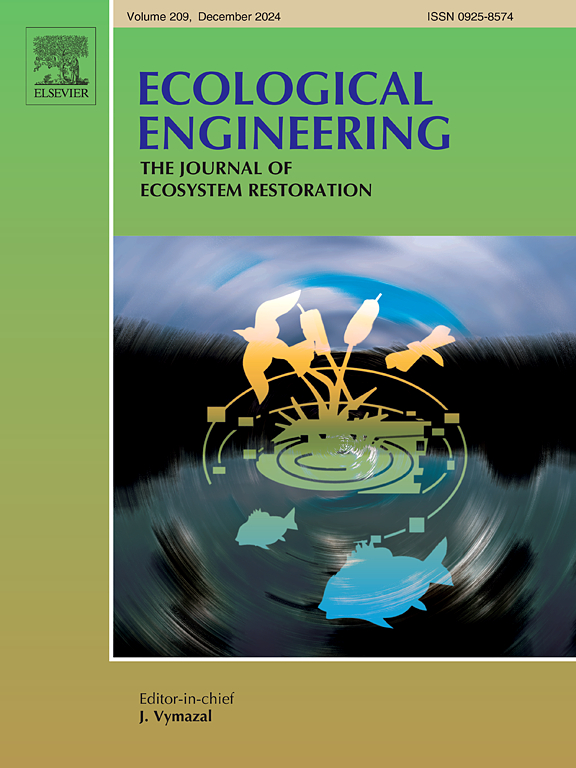Changes and driving of ecological environment quality in key ecological restoration projects implement zone in South China Karst
IF 4.1
2区 环境科学与生态学
Q1 ECOLOGY
引用次数: 0
Abstract
Ecological environment quality (EEQ) assessment is crucial for ecological management decisions making and coordinating ecological restoration and economic development in ecological restoration areas. As the largest karst contiguous area in the world and a key area for ecological restoration in China, the EEQ status of the South China Karst (SCK) is still unclear, and apply effective of karst remote sensing index (KRSEI) in big scale also dimness. Therefore, this study uses Google Earth Engine (GEE) to construct KRSEI, and uses Mann-Kendall and Hurst to evaluate the past and future trends of EEQ in SCK from 2001 to 2023. Then, using the partial least squares structural equation model (PLS-SEM) to reveal the driving force differences in EEQ between karst and non karst areas. The research results show that: (1) In the past 23 years, ecological restoration projects (ERPs) have effectively improved the EEQ in SCK, with the ecological improvement area accounting for 57.24 % of the total area, of which 68.78 % of the karst area, but it faces the risk of ecological degradation in the future; (2) The EEQ has shown a spatial distribution pattern of “high in the east and low in the west” in SCK, and the spatial accumulation type of “low-low” EEQ is decreasing, and Guizhou Province is the most typical; (3) The direct negative impact of human activities on EEQ is strengthening, and together with the climate, it indirectly weakens its positive effect on EEQ by directly affecting the terrain. This situation is more obvious in the karst region. This study provides a new perspective for the application and promotion of KRSEI on a large scale, and provides feasible suggestions for ERPs decision-making and management.
华南喀斯特重点生态修复工程实施区生态环境质量变化与驱动
生态环境质量评价是制定生态治理决策、协调生态修复与经济发展的重要依据。作为世界上最大的喀斯特连片区和中国生态修复的重点区域,华南喀斯特(SCK)的EEQ状况尚不清楚,岩溶遥感指数(KRSEI)在大尺度上的应用效果也不明显。因此,本研究使用谷歌Earth Engine (GEE)构建KRSEI,并使用Mann-Kendall和Hurst评估2001 - 2023年SCK EEQ的过去和未来趋势。然后,利用偏最小二乘结构方程模型(PLS-SEM)揭示喀斯特与非喀斯特地区EEQ驱动力差异。研究结果表明:(1)近23年来,生态修复工程(ERPs)有效改善了SCK生态环境质量,生态改善面积占总面积的57.24%,其中喀斯特面积占68.78%,但未来面临生态退化的风险;(2)高原EEQ呈“东高西低”的空间分布格局,“低-低”EEQ的空间积累类型呈递减趋势,以贵州省最为典型;(3)人类活动对EEQ的直接负面影响正在增强,并与气候一起通过直接影响地形间接削弱其对EEQ的正面影响。这种情况在喀斯特地区更为明显。本研究为KRSEI的大规模应用和推广提供了新的视角,并为erp决策和管理提供了可行性建议。
本文章由计算机程序翻译,如有差异,请以英文原文为准。
求助全文
约1分钟内获得全文
求助全文
来源期刊

Ecological Engineering
环境科学-工程:环境
CiteScore
8.00
自引率
5.30%
发文量
293
审稿时长
57 days
期刊介绍:
Ecological engineering has been defined as the design of ecosystems for the mutual benefit of humans and nature. The journal is meant for ecologists who, because of their research interests or occupation, are involved in designing, monitoring, or restoring ecosystems, and can serve as a bridge between ecologists and engineers.
Specific topics covered in the journal include: habitat reconstruction; ecotechnology; synthetic ecology; bioengineering; restoration ecology; ecology conservation; ecosystem rehabilitation; stream and river restoration; reclamation ecology; non-renewable resource conservation. Descriptions of specific applications of ecological engineering are acceptable only when situated within context of adding novelty to current research and emphasizing ecosystem restoration. We do not accept purely descriptive reports on ecosystem structures (such as vegetation surveys), purely physical assessment of materials that can be used for ecological restoration, small-model studies carried out in the laboratory or greenhouse with artificial (waste)water or crop studies, or case studies on conventional wastewater treatment and eutrophication that do not offer an ecosystem restoration approach within the paper.
 求助内容:
求助内容: 应助结果提醒方式:
应助结果提醒方式:


